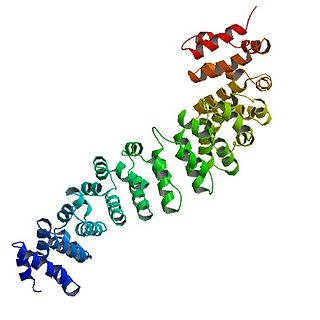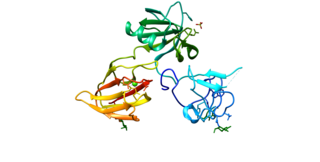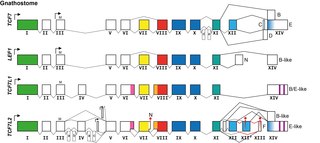SRY-box 17 is a protein that in humans is encoded by the SOX17 gene. [5]
SRY-box 17 is a protein that in humans is encoded by the SOX17 gene. [5]
The gene encodes a member of the SOX (SRY-related HMG-box) family of transcription factors, located on Chromosome 8 q11.23. Its gene body is isolated within a CTCF loop domain. [6] [7] [8] Approximately 230 kb upstream of SOX17 it has been identified a tissue specific differentially (hypo-)methylated region (DMR), which consists of SOX17 regulatory elements. [9] [10] The DMR in particular bears the most distal definitive endoderm-specific enhancer at the SOX17 locus. [11] SOX17 itself has recently been defined as so called topologically insulated gene (TIG). TIGs per definition are single protein coding genes (PCGs) within CTCF loop domains, that are mainly enriched in developmental regulators and suggested to be very tightly controlled via their 3D loop-domain architecture. [12]
SOX17 is involved in the regulation of vertebrate embryonic development and in the determination of the endodermal cell fate. The encoded protein acts downstream of TGF beta signaling (Activin) and canonical WNT signaling (Wnt3a). [13] [14] Especially the correct phosphorylation of SMAD2/3 within the respective cell cycle (early G1 phase) is crucial for the activation of cardinal endodermal genes (e.g. SOX17) to further enter the definitive endodermal lineage. [15] Besides that, perturbation of the SOX17 centromertic CTCF-boundary in early definitive endoderm differentiation, leads to massive developmental failure and a so-called mes-endodermal like trapped cell-state, which can be rescued by ectopic SOX17 expression. [16] In Xenopus gastrulae it has been shown that SOX17 modifies Wnt responses, where genomic specificity of Wnt/β-catenin transcription is determined through functional interactions between SOX17 and β-catenin/Tcf transcriptional complexes. [17]

Gastrulation is the stage in the early embryonic development of most animals, during which the blastula, or in mammals the blastocyst, is reorganized into a two-layered or three-layered embryo known as the gastrula. Before gastrulation, the embryo is a continuous epithelial sheet of cells; by the end of gastrulation, the embryo has begun differentiation to establish distinct cell lineages, set up the basic axes of the body, and internalized one or more cell types including the prospective gut.
In cellular biology, the Wnt signaling pathways are a group of signal transduction pathways which begin with proteins that pass signals into a cell through cell surface receptors. The name Wnt, pronounced "wint", is a portmanteau created from the names Wingless and Int-1. Wnt signaling pathways use either nearby cell-cell communication (paracrine) or same-cell communication (autocrine). They are highly evolutionarily conserved in animals, which means they are similar across animal species from fruit flies to humans.
A biochemical cascade, also known as a signaling cascade or signaling pathway, is a series of chemical reactions that occur within a biological cell when initiated by a stimulus. This stimulus, known as a first messenger, acts on a receptor that is transduced to the cell interior through second messengers which amplify the signal and transfer it to effector molecules, causing the cell to respond to the initial stimulus. Most biochemical cascades are series of events, in which one event triggers the next, in a linear fashion. At each step of the signaling cascade, various controlling factors are involved to regulate cellular actions, in order to respond effectively to cues about their changing internal and external environments.
SOX genes encode a family of transcription factors that bind to the minor groove in DNA, and belong to a super-family of genes characterized by a homologous sequence called the HMG-box. This HMG box is a DNA binding domain that is highly conserved throughout eukaryotic species. Homologues have been identified in insects, nematodes, amphibians, reptiles, birds and a range of mammals. However, HMG boxes can be very diverse in nature, with only a few amino acids being conserved between species.

Catenin beta-1, also known as β-catenin (beta-catenin), is a protein that in humans is encoded by the CTNNB1 gene.
The Casein kinase 1 family of protein kinases are serine/threonine-selective enzymes that function as regulators of signal transduction pathways in most eukaryotic cell types. CK1 isoforms are involved in Wnt signaling, circadian rhythms, nucleo-cytoplasmic shuttling of transcription factors, DNA repair, and DNA transcription.
In developmental biology, the cells that give rise to the gametes are often set aside during embryonic cleavage. During development, these cells will differentiate into primordial germ cells, migrate to the location of the gonad, and form the germline of the animal.
In the field of developmental biology, regional differentiation is the process by which different areas are identified in the development of the early embryo. The process by which the cells become specified differs between organisms.

Transcription factor 7-like 2 , also known as TCF7L2 or TCF4, is a protein acting as a transcription factor that, in humans, is encoded by the TCF7L2 gene. The TCF7L2 gene is located on chromosome 10q25.2–q25.3, contains 19 exons. As a member of the TCF family, TCF7L2 can form a bipartite transcription factor and influence several biological pathways, including the Wnt signalling pathway.

The development of fishes is unique in some specific aspects compared to the development of other animals.

In amniote embryology, the hypoblast is one of two distinct layers arising from the inner cell mass in the mammalian blastocyst, or from the blastodisc in reptiles and birds. The hypoblast gives rise to the yolk sac.

Glycogen synthase kinase-3 beta, (GSK-3 beta), is an enzyme that in humans is encoded by the GSK3B gene. In mice, the enzyme is encoded by the Gsk3b gene. Abnormal regulation and expression of GSK-3 beta is associated with an increased susceptibility towards bipolar disorder.

Lymphoid enhancer-binding factor 1 (LEF1) is a protein that in humans is encoded by the LEF1 gene. It is a member of T cell factor/lymphoid enhancer factor (TCF/LEF) family.

The LBH gene is a highly conserved human gene that produces the LBH protein, a transcription co-factor in the Wnt/β-catenin pathway. Upon transcriptional activation of β-catenin, LBH goes on to act as a regulator of cell proliferation and differentiation through multiple transcriptional targets. The gene is located on the p arm of chromosome 2 and is roughly 28 kb long. Current ongoing studies are examining its role in developmental and oncological settings.

Kremen protein 1 is a protein that in humans is encoded by the KREMEN1 gene. Kremen1 is conserved in chordates including amphioxus and most vertebrate species. The protein is a type I transmembrane receptor of ligands Dickkopf1, Dickkopf2, Dickkopf3, Dickkopf4, EpCAM and Rspondin1.

The TCF/LEF family is a group of genes that encode transcription factors which bind to DNA through a SOX-like high mobility group domain. They are involved in the Wnt signaling pathway, particularly during embryonic and stem-cell development, but also had been found to play a role in cancer and diabetes. TCF/LEF factors recruit the coactivator beta-catenin to enhancer elements of genes they target. They can also recruit members of the Groucho family of corepressors.

Gastruloids are three dimensional aggregates of embryonic stem cells (ESCs) that, when cultured in specific conditions, exhibit an organization resembling that of an embryo. They develop with three orthogonal axes and contain the primordial cells for various tissues derived from the three germ layers, without the presence of extraembryonic tissues. Notably, they do not possess forebrain, midbrain, and hindbrain structures. Gastruloids serve as a valuable model system for studying mammalian development, including human development, as well as diseases associated with it. They are a model system an embryonic organoid for the study of mammalian development and disease.

SRY-box 7 is a protein that in humans is encoded by the SOX7 gene.
A developmental signaling center is defined as a group of cells that release various morphogens which can determine the fates, or destined cell types, of adjacent cells. This process in turn determines what tissues the adjacent cells will form. Throughout the years, various development signaling centers have been discovered.

Dishevelled binding antagonist of beta catenin 1 is a protein that in humans is encoded by the DACT1 gene. Dact1 was originally described in 2002 as a negative regulator of Wnt signaling by binding and destabilizing Dishevelled. More recent investigation into the molecular function of Dact1 has identified its principle role in the cell as a scaffold to generate membrane-less biomolecular condensates through liquid-liquid phase separation. Mutations in the phase-separating regions of Dact1 lead to Townes-Brock Syndrome 2 while its overexpression is associated with bone metastasis.
This article incorporates text from the United States National Library of Medicine, which is in the public domain.